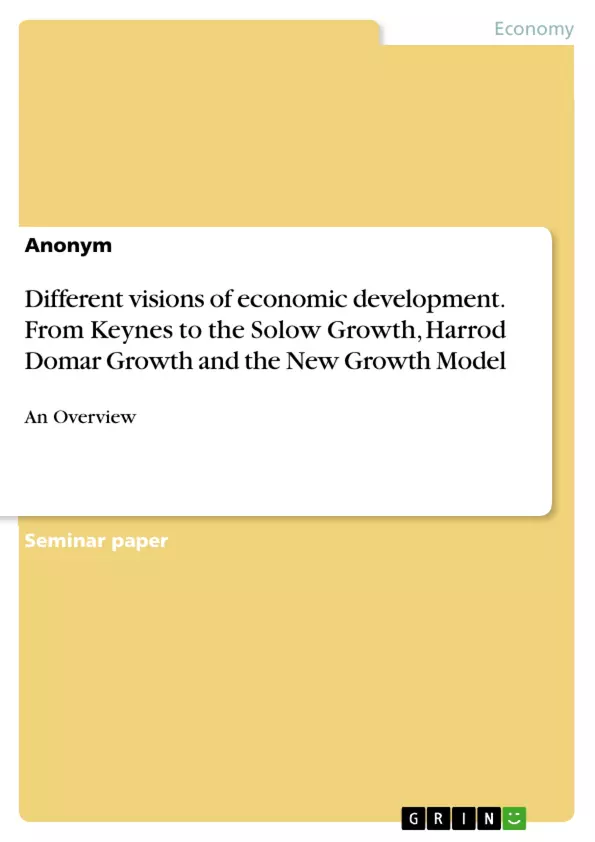In this article four economic development models are described. The first one is the basis of the neoclassical theory of economic growth, the Solow model which deals with the exogenous growth. The second model is from Keynes. The third one is the Harrod-Domar model which is the basis of the Postkeynesian theory of economic growth and the last model deals with the endogenous growth and forms the basis for the new-classical theory of economic growth.
In the following four different models are indicated with the help of the method of the literature-based analysis. In every economic development model the origin, the acceptances and the criticism are performed and the frame of this work is not enough to give every derivation. In the end the result summarizes this housework.
Inhaltsverzeichnis (Table of Contents)
- Introduction
- Solow growth model
- Origin of the model
- Assumptions of the model
- Criticism of the model
- Keynesian growth model
- Origin of the model
- Assumptions of the model
- Criticism of the model
- Harrod-Domar growth model
- Origin of the model
- Assumptions of the model
- Criticism of the model
- New growth model
- Origin of the model
- Assumptions of the model
- Criticism of the model
Zielsetzung und Themenschwerpunkte (Objectives and Key Themes)
This article aims to analyze four economic development models: the Solow model, the Keynesian model, the Harrod-Domar model, and the New Growth model. The primary objective is to delve into the origins, assumptions, and criticisms of each model, providing a comprehensive overview of the evolution of economic growth theory.
- Neoclassical theory of economic growth
- Keynesian theory of economic growth
- Postkeynesian theory of economic growth
- New-classical theory of economic growth
- Exogenous and endogenous growth
Zusammenfassung der Kapitel (Chapter Summaries)
- Introduction: This chapter provides a historical overview of economic thought, tracing the development of economics as a distinct science. It introduces the concept of economic growth and highlights the four models that will be explored in detail.
- Solow growth model: This chapter focuses on the Solow model, a cornerstone of the neoclassical theory of economic growth. It examines the model's origin, assumptions, such as the production function, capital accumulation, and technological progress, and its limitations. The chapter delves into the concept of a steady state, where economic variables grow at a constant rate, and explains how technological progress plays a crucial role in driving economic growth in the Solow model.
- Keynesian growth model: This chapter explores the Keynesian model of economic growth, contrasting it with the neoclassical approach. It examines the model's origin, assumptions, and its critiques, highlighting the role of government intervention and demand management in driving economic growth.
- Harrod-Domar growth model: This chapter focuses on the Harrod-Domar model, a key element of the Postkeynesian theory of economic growth. It analyzes the model's origin, assumptions, and criticisms, emphasizing its focus on the relationship between saving, investment, and economic growth. The chapter explores the model's limitations in explaining long-term growth and its contributions to understanding the dynamics of developing economies.
Schlüsselwörter (Keywords)
The text focuses on the key concepts and theories of economic growth, including: neoclassical growth, Keynesian growth, Postkeynesian growth, new-classical growth, Solow model, Keynesian model, Harrod-Domar model, endogenous growth, exogenous growth, technological progress, capital accumulation, production function, steady state, and government intervention.
- Quote paper
- Anonym (Author), 2015, Different visions of economic development. From Keynes to the Solow Growth, Harrod Domar Growth and the New Growth Model, Munich, GRIN Verlag, https://www.grin.com/document/310383



